Micromobility
Micromobility refers to a range of small, lightweight devices operating at speeds typically below 25 km/h (15 mph) and both either owned or hired by the one of the users. Micromobility devices include bicycles, Ebikes, electric scooters, electric skateboards, shared bicycles, and electric pedal assisted (pedelec) bicycles.[1]
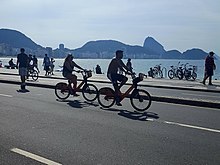
Initial definitions set the primary condition for inclusion in the category of micromobility to be a gross vehicle weight of less than 500 kilograms (1,100 lb).[2] However, the definition has evolved to exclude devices with internal combustion engines and those with top speeds above 45 kilometres (28 mi)/h.
The term evokes a transition similar to that of microcomputing where the miniaturization of transport modes for short journeys parallels the miniaturization of microcomputers for personal use. The term was coined by business and technology analyst Horace Dediu, in a speech he delivered in 2017 at the Micromobility Summit in the Techfestival event in Copenhagen.[3]
Characteristics
Micromobility devices can be human-powered or electric, and can be privately-owned or available through a shared fleet. Most micromobility devices are considered to be low-speed (top speed of 25 kilometres (16 mi)/h), but devices can have speeds up to 45 kilometres (28 mi)/h and still be considered micromobility. Some speed pedelec and electric kick scooter models fall into this moderate speed subcategory.
Any vehicle with an internal combustion engine cannot be defined as micromobility, nor can devices with top speeds above 45 km/h.
History
Original forms of micromobility, like bicycles and scooters, have both been around since 1817, and it was not until 1908 that cars came to dominate in modal share in cities such as New York.[4] Since then, use of bicycles as a utilitarian urban transport mode (as opposed to for recreation or sport) has been relatively low in comparison to trips made by private vehicles outside of a handful of cities in China, the Netherlands, and Denmark.
In 1655, Stephan Farffler, a 22-year-old paraplegic watchmaker, built the world's first self-propelling chair on a three-wheel chassis using a system of cranks and cogwheels.[5][6] However, the device had an appearance of a hand bike more than a wheelchair since the design included hand cranks mounted at the front wheel.
The invalid carriage or Bath chair brought the technology into more common use from around 1760.[7]
William Kent developed an early stroller in 1733.[8] Strollers became affordable and widespread due to new manufacturing materials in the 1930s.
The push scooter was invented by Denis Johnson in 1819 and usually constructed mainly from wood. Motorised scooters first appeared as autopeds enjoying a brief boom in popularity in 1915.[9]. The aluminium folding scooter popularised the push scooter in the 1990s.[10] E-scooters first appeared in 2003.[11]
In 1882 a sports newspaper in Stockholm first reported a kicksled as a vehicle that could be kicked forwards on ice and snow.[12]
In 1965, Owen Maclaren designed a lightweight stroller with an aluminium frame further popularising the stroller. In the 1960s and 1970s skateboards enjoyed popularity, displacing kick scooters which nearly disappeared completely.
Pedal
The pedal powered tricycle was invented by two Frenchmen, named Blanchard and Maguier in 1789. It predates the invention of the Bicycle in Germany by Karl von Drais in 1817 (which did not use pedals until the 1860s). Tricycles were not popular until 1876, when James Starley introduced the Coventry Lever Tricycle, a side-driven two-track, lever-driven machine, and that started the tricycling craze in Great Britain. [13] This was replaced with the bike boom of the 1890s as a result of the popular introduction of Starley's safety bicycle.
Human-powered quadracycles were invented in 1853 and enjoyed modest popularity[14]. This was followed by quadricycles in 1896 which included a motor. Recumbent bicycles were invented in 1893. Velomobiles (essentially enclosed recumbents) were invented in 1927. Velocars were invented by Mochet in 1932. The first mass produced electric velomobile was the Sinclair C5.
Rental
While micromobility vehicles have long been available for users to purchase, it was the servitization of these modes of transportation—enabling users to use the nearest micromobility vehicle without having to purchase or store it, and facilitating the flexibility of one-way trips—that led to unprecedented growth[15] in areas where it was available. The rise of the sharing economy resulted in a massive increase in access to micromobility in many cities, first with the introduction of public bikeshare systems, and then with privately funded and operated dockless bikeshare and electric kick scooter (e-scooter) fleets. Most early bikeshare services specified locations, or docks, where vehicles needed to be picked up and left.
21st Century
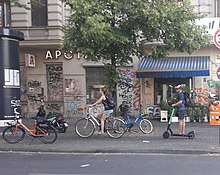
The second generation was dockless bicycle-sharing introduced in 2000, the third was dockless electric bicycle sharing introduced in 2017.[16]
The fourth generation of bicycle sharing services employed a dockless model which allows users to end their trip and leave the shared micromobility device anywhere or within a geo-fenced area. Dockless bikeshare first took off in Chinese megacities,[17] and although it began with traditional, non-electric bicycles, it served as a template for what would be possible with electric and motorized bicycles, scooters, and other form factors. The availability of relatively inexpensive batteries, displays and GPS receivers, enabled by the smartphone supply chains, provided easily accessible components to facilitate dockless services worldwide.[18] Outside of Chinese cities, non-electric dockless bikeshare has largely disappeared, with many companies switching from bicycles to electric kick scooters in 2019.[19]

Shared electric kick scooters are considered to have one of the most rapid adoption rates in transport, nearly 4% in one year. Comparatively, it took bikeshare eight years to reach 13% adoption, and carshare 18 years to reach 16% in major United States cities.[20]
Popularity and reception
The speed of micromobility diffusion has not come without growing pains. Some cities were caught off guard with the sudden influx of shared dockless vehicles, especially after companies launched their fleets without municipal approval.[21] In 2018, Seattle became the first US city to establish a permanent regulatory permit requiring shared dockless vehicle operators to meet certain requirements in order to provide service in the city.[22] Many other cities followed suit, drafting regulatory frameworks that would permit these services and more seamlessly integrate them with existing transportation.[23]
Operators, users and municipalities are moving toward an equilibrium where the benefits of micromobility have become apparent.[24] Micromobility users have reported replacing between one-quarter[25] and one-third[26] of car trips with micromobility, and many users report being able to take trips they otherwise would not or could not have made if micromobility options were not available. The potential for micromobility to replace automobile trips, coupled with financial opportunities presented by the massive injection of venture capital into the industry, has led to global automakers such as Ford and General Motors to invest in micromobility services.[27]
However, data shows that micromobility users also replace public transit (notably, bus) and walking trips. Concerns have also been raised about the life-cycle emissions of electric micromobility modes such as e-scooters,[28] as well as the long-term financial viability of micromobility companies given minimal differences between product offerings and operating costs in the hundreds of millions of US dollars.[29]
Classification
Within the EU vehicle categorization micromobility vehicles fall under the L category, and are excluded from the M, N, O and higher categories.
Devices that fall within the definition of micromobility are typically classified as bicycles and are permitted to use bicycle infrastructure such as protected bicycle lanes, cycle tracks, cycle highways, and off-street trails. Classification as bicycles also means that users of personal micromobility modes are not required to register them, pay vehicle registration fees, or maintain liability insurance.[30][31]
Infrastructure
Infrastructure for micromobility can include cycle lanes, ramps and docking stations. Many cycle lanes only permit bicycles.
Top 10 United States cities for micromobility potential
According to INRIX,[32][33] the following United States cities had the highest micromobility potential in 2019:
| Rank | City |
|---|---|
| 1 | Honolulu |
| 2 | New Orleans |
| 3 | Nashville |
| 4 | Chicago |
| 5 | Charlotte |
| 6 | New York City |
| 7 | Portland |
| 8 | Pittsburgh |
| 9 | Los Angeles |
| 10 | San Francisco |
List of vehicles
- Bicycle
- Golf cart
- Handcycle
- Hobcart
- Hoverboard
- Kick scooter
- Microcar (some)
- Mobility scooter
- Onewheel (board)
- Quadracycle
- Roller skates
- Segway
- Skateboard
- Stroller
- Tricycle
- Unicycle
- Velomobile
- Wheelchair
Gallery
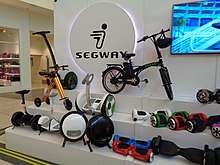 Segway, hoverboard, electric unicycle, a-bike, electric bicycle
Segway, hoverboard, electric unicycle, a-bike, electric bicycle- Recumbent bike
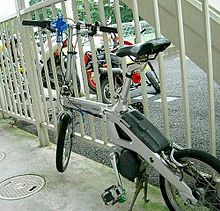 First folding electric bike Honda Step Compo
First folding electric bike Honda Step Compo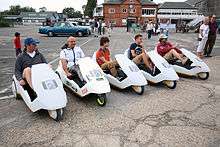 Sinclair C5, the first mass-produced electric velomobile
Sinclair C5, the first mass-produced electric velomobile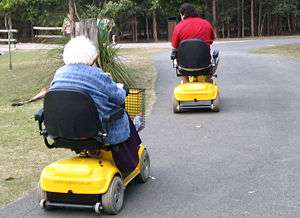 Mobility scooter
Mobility scooter Roller Buggy baby stroller
Roller Buggy baby stroller.jpg) Electric golf cart
Electric golf cart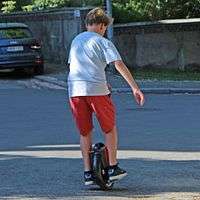 Solowheel
Solowheel
References
- Institute for Transportation and Development Policy (2019). "The Electric Assist: Leveraging E-bikes and E-scooters for More Livable Cities" (PDF). Retrieved April 7, 2020.
- Dediu, Horace. "The Micromobility Definition". micromobility.io. Retrieved 23 October 2019.
- "Micromobility Summit".
- Sovacool, Benjamin K. (1 March 2009). "Early modes of transport in the United States: Lessons for modern energy policymakers". Policy and Society. 27 (4): 411–427. doi:10.1016/j.polsoc.2009.01.006. ISSN 1449-4035.
- Bellis, Mary. "History of the Wheelchair". thoughtco.com. Retrieved April 14, 2017.
- Koerth-Baker, Maggie. "Who Invented the Wheelchair?". mentalfloss.com. Retrieved April 14, 2017.
- "A History of the World – Object: Bath Chair". BBC. 2012-09-02. Retrieved 2012-11-19.
- On foot: a history of walking - Google Book Search. books.google.co.uk. Retrieved 2009-03-24.
- https://www.smithsonianmag.com/history/motorized-scooter-boom-hit-century-dockless-scooters-180971989/
- https://thegioitienganhvietnam.wordpress.com/history-about-kick-scooter/
- https://www.bloomberg.com/news/articles/2018-09-26/how-a-kids-scooter-became-a-micro-mobility-revolution
- https://bubblebikestore.co.uk/blogs/news/brief-history-of-kick-scooters
- https://tricyclemuseum.wordpress.com/2-history-of-tricycles/
- http://www.bicyclehistory.net/bicycle-history/history-of-quadracycles/
- "Lime, Bird, Spin: Why scooter start-ups are suddenly worth billions". 2018-07-13.
- "The Three Eras of Micromobility". Micromobility Industries.
- "China's Bike-Sharing Fever Has Reached Saturation Point".
- Belton, Padraig (2018-05-15). "How cheap dockless hire bikes are flooding the world". BBC News.
- Vuocolo, Alex (2019-03-04). "Why Are Bike Share Companies Pivoting to E-Scooters?". Bicycling. Retrieved 2020-04-07.
- Clewlow, Regina (2018-08-06). "The Micro-Mobility Revolution". Medium. Retrieved 2020-04-07.
- Lazo, Luz. "Dockless bike, scooter firms clash with U.S. cities over regulations". chicagotribune.com. Retrieved 2020-04-07.
- "Seattle Bikeshare Program & Permit Process". MOD Learning Center. Retrieved 2020-04-07.
- Manchester, Julia (2018-12-12). "Growing use of e-scooters reflects increasing demand for micro-mobility, says tech CEO". TheHill. Retrieved 2019-01-18.
- Feasley, Levi Tillemann ,Lassor (2018-12-07). "Forget the Car. E-Scooters Could Save The City". Wired. ISSN 1059-1028. Retrieved 2019-01-18.
- Lime (October 2019). "Lime for a Sustainable Paris" (PDF). Retrieved April 7, 2020.
- Portland Bureau of Transportation (2018). "2018 E-Scooter Findings Report". Retrieved April 7, 2020.
- Rosevear, John (2018-12-07). "Micromobility 101 for Investors -". The Motley Fool. Retrieved 2019-01-18.
- Moreau, Hélie; de Jamblinne de Meux, Loïc; Zeller, Vanessa; D’Ans, Pierre; Ruwet, Coline; Achten, Wouter M. J. (January 2020). "Dockless E-Scooter: A Green Solution for Mobility? Comparative Case Study between Dockless E-Scooters, Displaced Transport, and Personal E-Scooters". Sustainability. 12 (5): 1803. doi:10.3390/su12051803.
- Bliss, Laura. "4 Predictions for the Electric Scooter Industry". CityLab. Retrieved 2020-04-07.
- Reid, Carlton. "EU Electric Bike Riders Will Not Need Compulsory Insurance Decides European Parliament". Forbes. Retrieved 2020-04-07.
- "E-Bike Law Primer" (PDF). People for Bikes. April 2018. Retrieved April 7, 2020.
- Wu, Nina (2019-09-12). "Study ranks Honolulu tops in micromobility potential". Star-Advertiser. Honolulu. Retrieved 2019-09-13.
- "Shared Bikes and Scooters Could Replace Nearly 50 Percent of Downtown Vehicle Trips: New INRIX Research ranks the top U.S., U.K. and German cities where micromobility has the most potential". INRIX. Kirkland, Washington. 2019-09-09. Retrieved 2019-09-13.